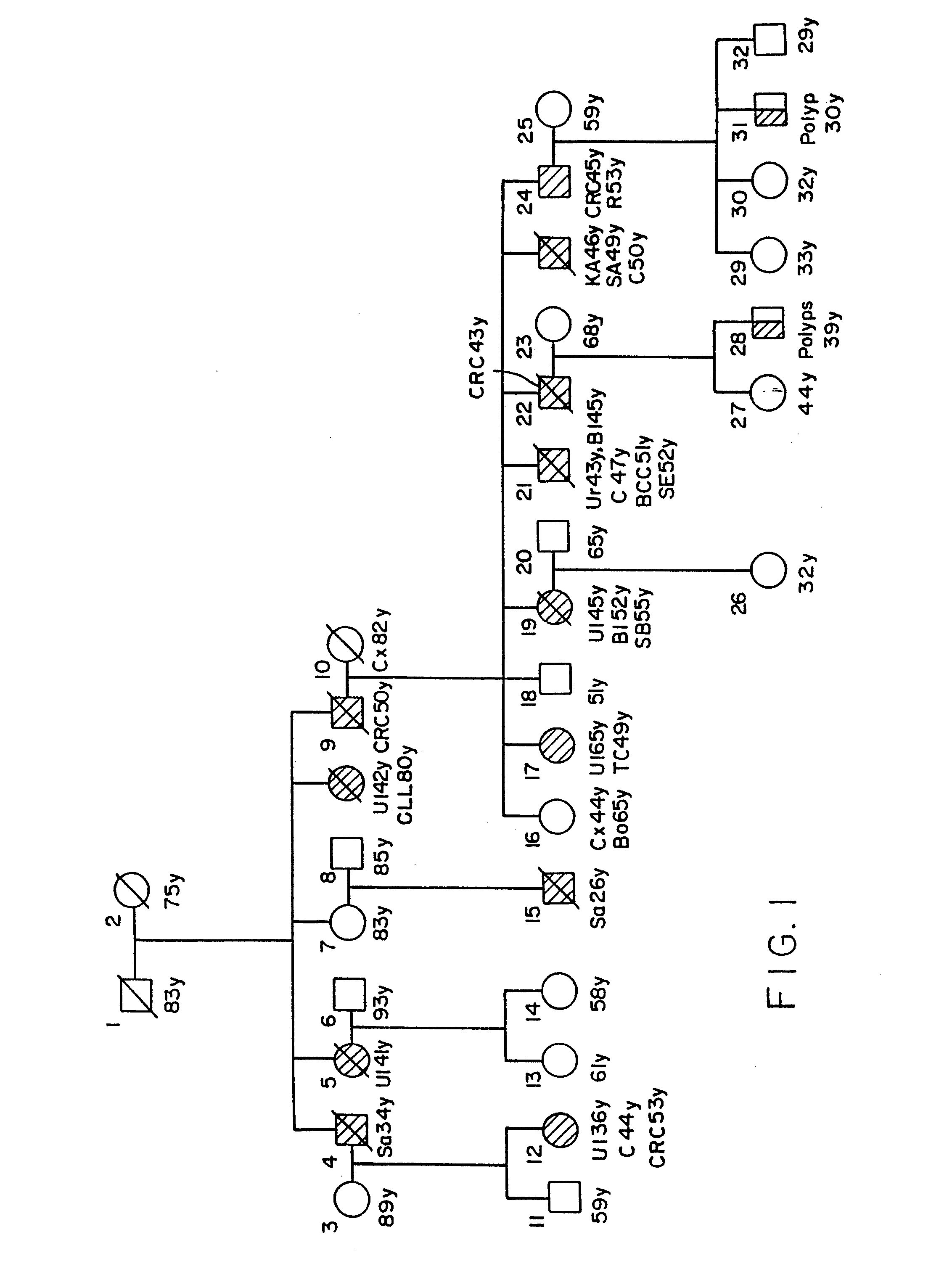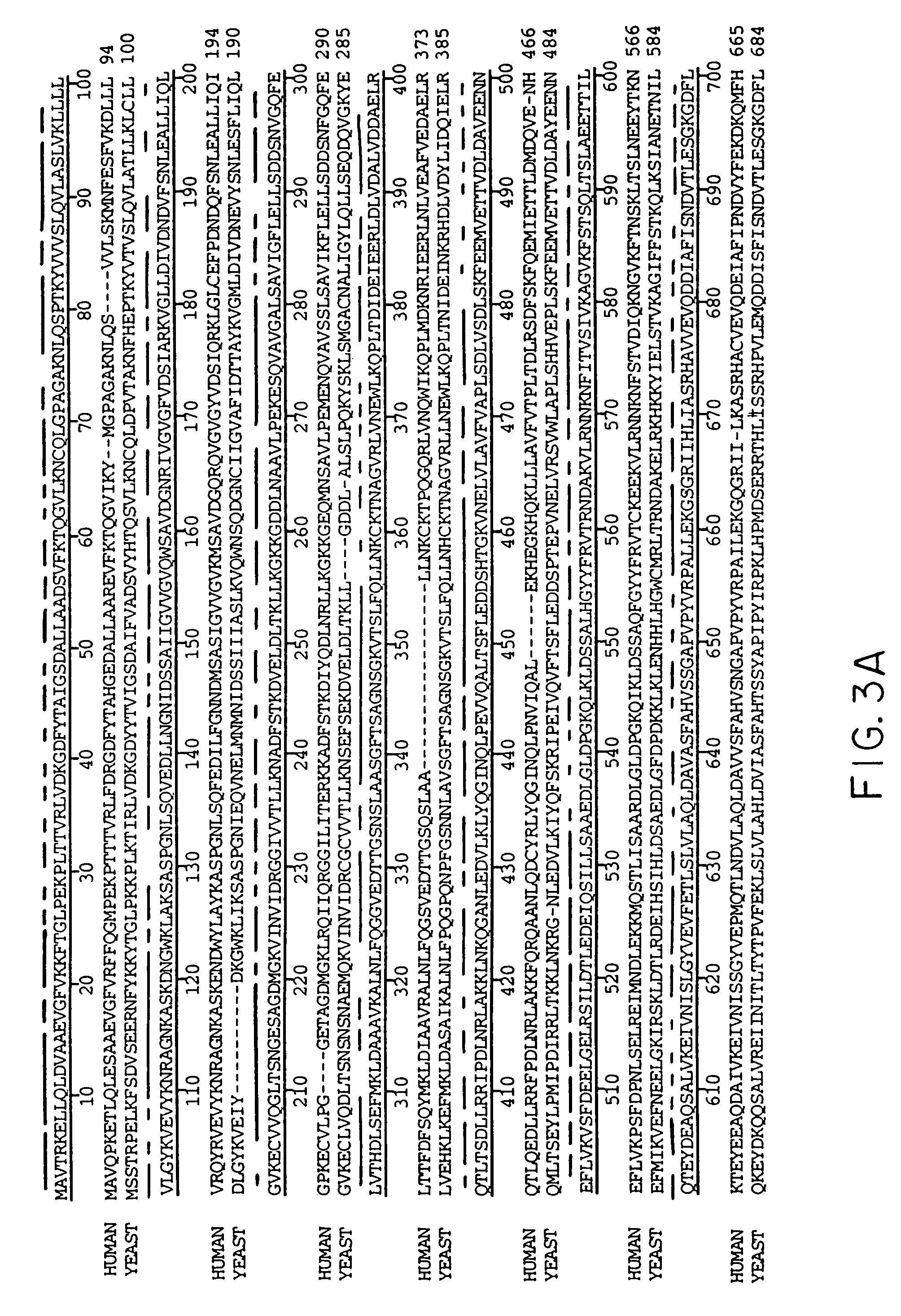Method for detection of alterations in the DNA mismatch repair pathway
a dna mismatch and repair pathway technology, applied in the field of eukaryotic dna mismatch repair pathway detection, can solve problems such as accumulation of unstable repeated dna sequences, and achieve the effect of high correlation to disease sta
- Summary
- Abstract
- Description
- Claims
- Application Information
AI Technical Summary
Benefits of technology
Problems solved by technology
Method used
Image
Examples
example 1
Isolation and Characterization of Yeast Homologues of the E. coli mutS Mismatch Repair Gene
Materials and Methods
[0204]Enzymes and chemicals: Restriction enzymes were from New England Biolabs (Beverly, Mass.). T4 DNA ligase was prepared using a method similar to that of Tait et al. 1980. The Klenow fragment of DNA polymerase I and a random primed DNA labeling kit were obtained from Boehringer Mannheim (Indianapolis, Ind.). Taq DNA polymerase was purchased from Perkin Elmer-Cetus (Norwalk, Conn.). Sequenase DNA sequencing kits were from U.S. Biochemical Corp. (Cleveland, Ohio). [a-32P]dATP used in random primed labeling and [a-35S]dATP used in DNA sequencing were from Amersham (Arlington Heights, Ill.).
[0205]Oligonucleotides: Oligonucleotides were synthesized on an Applied Biosystems 380A DNA synthesizer using phosphoramidite chemistry and deprotected using standard methods. Degenerate oligonucleotides for polymerase chain reactions (PCR) were further purified by electrophoresis throu...
example 2
Function of Yeast Homologues of the E. Coli mutS Mismatch Repair Gene
[0216]Enzymes and chemicals: Chemicals, enzymes and oligonucleotides are as described above in Example 1.
[0217]Strains and media: The S. cerevisiae strains used in this study are derived from SK1 and were the gift of Nancy Kleckner (Harvard University, Cambridge, Mass.). Methods for the construction and manipulation of these strains have been described elsewhere (Tishkoff, Johnson and Kolodner 1991; Cao, Alani and Kleckner 1990). The two strain combinations NK859: MA Ta ho::LYS2 lys2 ura3 leu2::hisG his4x and NK860: MA Ta ho::LYS2 lys2 ura3 leu2::hisG his4b or NK858: MATa ho::LYS2 lys2 ura3 leu2::hisG his4x and NK861: MATa ho::LYS2 lys2 ura3 leu2::G his4b were crossed to construct the diploids used for all MSH gene disruptions. Haploid strains bearing the MSH gene insertion mutations in combination with a particular HIS4 allele were generated as needed from the disruption heterozygotes and used for phenotypic chara...
example 3
Isolation and Characterization of a Human Homologue of the E. coli mutS Mismatch Repair Gene
Materials and Methods
[0230]Chemicals, Enzymes, Oligonucleotides, DNAs, Libraries and Vectors
[0231]Ultrapure Tris (acid and base), Ethylenediaminetetraacetic acid (EDTA), MgCl2, MgSO4, NaCl, and analytical grade sodium citrate, KCl, potassium phosphate monobasic (KH2PO4) and sodium phosphate dibasic (Na2HPO4) were obtained from Amresco (Solon, Ohio). Ultra pure glycerol was obtained from Mallinckrodt, Inc. (Paris, Ky.). Deoxyribonucleoside triphosphates and ATP were purchased from Pharmacia LKB Biotechnology, Inc. (SWEDEN). NIGMS mapping pannel 2 DNAs were from Coriell Cell Respositories (Camden, N.J.) and a Southern transfer of a BamHI digest of these DNAs used in preliminary experiments was from Oncor (Gaithersburg, Md.). Gelatin was purchased from Sigma (St. Louis, Mo.). Restriction endonucleases and T4 DNA Ligase were purchased from New England Biolabs, Inc. (Beverly, Mass.). Calf Intestin...
PUM
 Login to View More
Login to View More Abstract
Description
Claims
Application Information
 Login to View More
Login to View More - R&D
- Intellectual Property
- Life Sciences
- Materials
- Tech Scout
- Unparalleled Data Quality
- Higher Quality Content
- 60% Fewer Hallucinations
Browse by: Latest US Patents, China's latest patents, Technical Efficacy Thesaurus, Application Domain, Technology Topic, Popular Technical Reports.
© 2025 PatSnap. All rights reserved.Legal|Privacy policy|Modern Slavery Act Transparency Statement|Sitemap|About US| Contact US: help@patsnap.com



